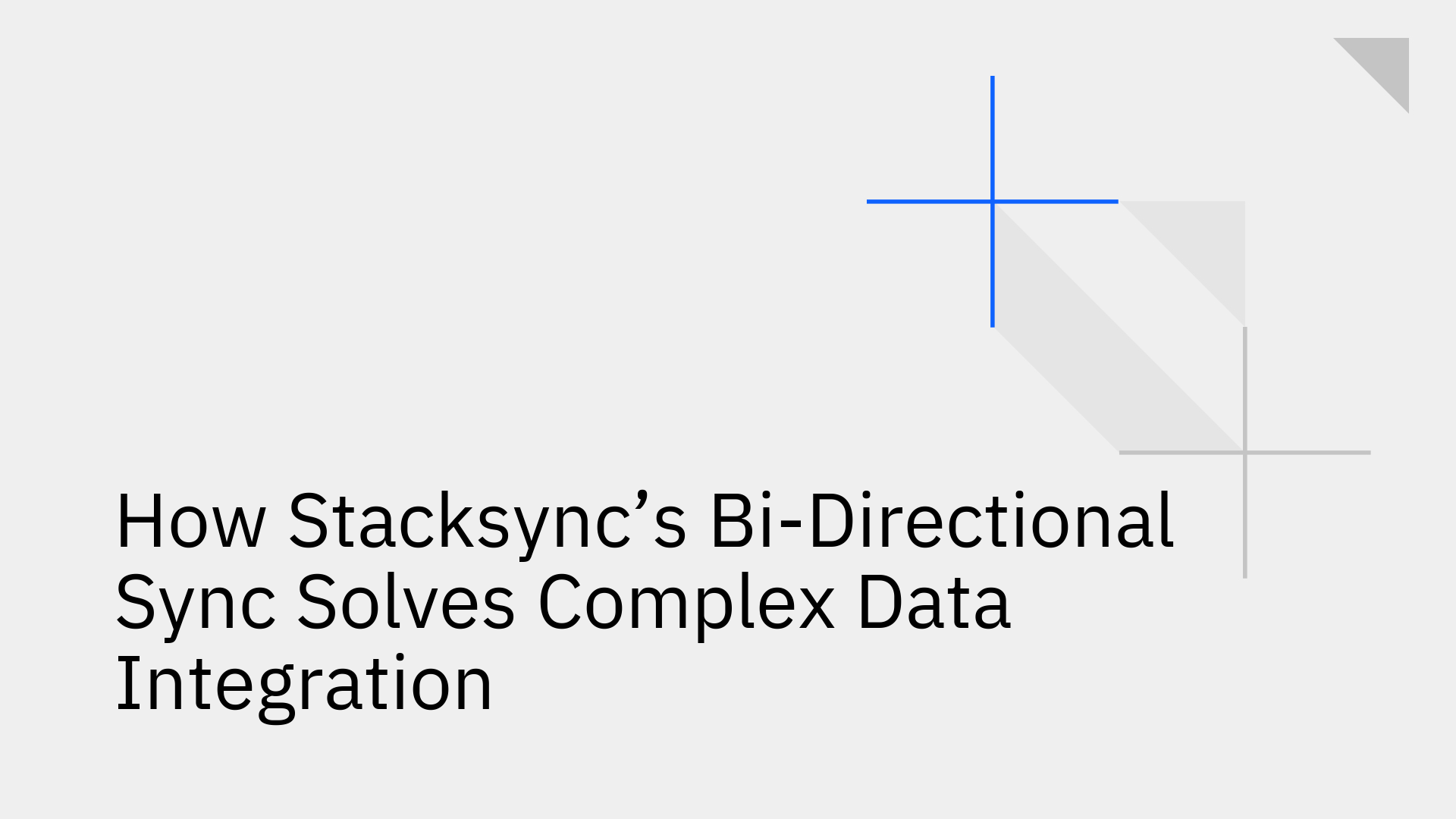
Enterprises operate on a complex web of specialized systems—CRMs, ERPs, and databases—that must work in concert. The technical challenge is maintaining data consistency across these disparate environments. Traditional integration methods, such as building custom code or leveraging generic iPaaS solutions, often fail to deliver the required performance and reliability. Custom integrations are brittle, resource-intensive to maintain, and struggle to scale. Generic iPaaS platforms, while flexible, are not purpose-built for the complexities of true bi-directional synchronization, often resulting in high latency, complex conflict resolution logic, and silent data failures. This creates a significant operational drag, forcing engineering teams to spend valuable cycles on "dirty API plumbing" instead of building core product value.
Stacksync provides a purpose-built solution engineered to solve these fundamental data integration challenges. It delivers conflict-free, real-time, and secure bi-directional synchronization that eliminates the complexity of keeping operational systems perfectly aligned.
For mission-critical operations, data latency is not an option. A delay between a customer update in a CRM and its reflection in a billing database can directly impact revenue and customer satisfaction. Stacksync real-time sync is designed for these use cases, enabling data consolidation and synchronization at scale with millisecond processing speeds.
Unlike solutions that simulate two-way sync by running two separate one-way syncs, Stacksync’s engine is architected for true bi-directionality. This ensures that a change made in any connected system is propagated to all others instantly and accurately, maintaining data consistency across the entire ecosystem.
Key technical features that enable this performance include:
Ultra-Efficient Event Queues: Stacksync utilizes managed event queues to buffer and batch event processing efficiently. This architecture handles high-volume data changes, processing millions of executions per minute without requiring users to manage complex infrastructure.
Adaptive API Rate Limits: To prevent service disruptions and quota overruns, the platform employs smart API rate limits that dynamically adapt to traffic and resource budgets, ensuring reliable performance without overwhelming connected systems.
Flexible Configuration: The platform supports both no-code setup for rapid implementation and pro-code configurations, giving teams the flexibility to manage integrations in a way that fits their workflow.
Data integration failures can be catastrophic, leading to data corruption and operational downtime. A common failure point in traditional integrations is the "silent sync failure," where data stops flowing without any notification, leading to severe data drift.
Stacksync is built for high reliability, with a suite of features designed to prevent data loss and provide transparent governance over data flows.
Conflict-Free Integration: The platform is designed to manage simultaneous updates, ensuring changes are reflected across systems without creating data conflicts or disrupting business operations.
Issue Management Dashboards: Centralized dashboards provide complete visibility into sync status. In the event of a failure, teams are immediately alerted and can use the dashboard to diagnose, retry, or revert the failed sync, eliminating the risk of silent failures.
Workflow Versioning and Rollback: Stacksync maintains versions of all workflows, allowing for instant rollbacks to a previous stable state. This provides a critical safety net, ensuring that any problematic changes can be immediately undone.
Comprehensive Monitoring and Logging: The platform integrates real-time monitoring, alerting, and advanced log exploration tools. This gives teams proactive control and deep visibility into every step of the synchronization process for rapid issue resolution and auditing.
| Feature | Stacksync Approach | Traditional Methods (Custom Code / Generic iPaaS) |
|---|---|---|
| Sync Model | True, real-time bi-directional sync | One-way batch processing or two fragile one-way syncs |
| Conflict Resolution | Automated, conflict-free by design | Requires complex, custom-coded logic; prone to errors |
| Error Handling | Centralized dashboards, alerts, instant rollback | Manual log parsing, risk of silent failures, difficult recovery |
| Maintenance | Fully managed platform, no infrastructure overhead | High maintenance, requires dedicated DevOps resources |
| Scalability | Effortless scaling to millions of records/minute | Requires manual infrastructure scaling and performance tuning |
For any enterprise, data security is non-negotiable. Integrating systems must not create new attack vectors or compliance risks. Stacksync enterprise security is architected with a security-first principle, ensuring that data is protected at every stage of the integration lifecycle.
A core tenet of Stacksync's security model is that customer data is never persisted on Stacksync infrastructure. Data passes through the system for processing but is never stored, minimizing the attack surface. Users can also select the geographic region for data processing to ensure compliance with data sovereignty regulations like GDPR.
Key security and compliance features include:
End-to-End Encryption: All data is protected in transit with TLS 1.2+ and at rest using AES encryption with regularly rotating keys, preventing unauthorized access.
Secure Connection Options: The platform supports a comprehensive range of secure connection methods, including OAuth 2.0, SSH tunneling, SSL certificates, IP whitelisting, VPN gateways, and VPC peering, to meet stringent enterprise network requirements.
Granular Access Control: Role-Based Access Control (RBAC) allows administrators to define granular user permissions. Operations can be restricted within workspaces, and certain actions, like record deletion, can be disabled entirely to prevent accidental data loss.
Compliance and Certifications: Stacksync is compliant with major standards and regulations, including SOC 2 Type II, GDPR, HIPAA BAA, ISO 27001, and CCPA, providing independently verified assurance of its security posture.
By moving beyond the limitations of traditional integration methods, Stacksync provides a robust, secure, and efficient solution for complex data synchronization. The platform’s focus on true Stacksync bi-directional sync, real-time performance, and enterprise-grade security empowers engineering teams to eliminate brittle, time-consuming integration work. This allows them to focus on building core business logic and delivering value, confident that their underlying data infrastructure is consistent, reliable, and secure.